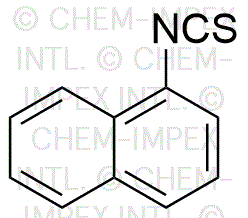1-Naphthyl isothiocyanate is widely utilized in research focused on:
- Biological Research: This compound is often used in studies investigating the mechanisms of cancer cell growth inhibition, providing insights into potential therapeutic strategies.
- Pesticide Development: It serves as a key ingredient in formulating natural pesticides, offering an eco-friendly alternative to synthetic chemicals in agriculture.
- Flavor and Fragrance Industry: Its unique aroma makes it valuable in creating specific scents and flavors, enhancing products in the food and cosmetic sectors.
- Analytical Chemistry: It is employed as a reagent for detecting various compounds in analytical methods, improving the accuracy and reliability of chemical analyses.
- Pharmaceutical Research: Researchers explore its potential in drug development, particularly for its ability to modify biological activity and improve efficacy in medicinal compounds.
General Information
Properties
Safety and Regulations
Applications
1-Naphthyl isothiocyanate is widely utilized in research focused on:
- Biological Research: This compound is often used in studies investigating the mechanisms of cancer cell growth inhibition, providing insights into potential therapeutic strategies.
- Pesticide Development: It serves as a key ingredient in formulating natural pesticides, offering an eco-friendly alternative to synthetic chemicals in agriculture.
- Flavor and Fragrance Industry: Its unique aroma makes it valuable in creating specific scents and flavors, enhancing products in the food and cosmetic sectors.
- Analytical Chemistry: It is employed as a reagent for detecting various compounds in analytical methods, improving the accuracy and reliability of chemical analyses.
- Pharmaceutical Research: Researchers explore its potential in drug development, particularly for its ability to modify biological activity and improve efficacy in medicinal compounds.
Documents
Safety Data Sheets (SDS)
The SDS provides comprehensive safety information on handling, storage, and disposal of the product.
Product Specification (PS)
The PS provides a comprehensive breakdown of the product’s properties, including chemical composition, physical state, purity, and storage requirements. It also details acceptable quality ranges and the product's intended applications.
Certificates of Analysis (COA)
Search for Certificates of Analysis (COA) by entering the products Lot Number. Lot and Batch Numbers can be found on a product’s label following the words ‘Lot’ or ‘Batch’.
*Catalog Number
*Lot Number
Certificates Of Origin (COO)
This COO confirms the country where the product was manufactured, and also details the materials and components used in it and whether it is derived from natural, synthetic, or other specific sources. This certificate may be required for customs, trade, and regulatory compliance.
*Catalog Number
*Lot Number
Safety Data Sheets (SDS)
The SDS provides comprehensive safety information on handling, storage, and disposal of the product.
DownloadProduct Specification (PS)
The PS provides a comprehensive breakdown of the product’s properties, including chemical composition, physical state, purity, and storage requirements. It also details acceptable quality ranges and the product's intended applications.
DownloadCertificates of Analysis (COA)
Search for Certificates of Analysis (COA) by entering the products Lot Number. Lot and Batch Numbers can be found on a product’s label following the words ‘Lot’ or ‘Batch’.
*Catalog Number
*Lot Number
Certificates Of Origin (COO)
This COO confirms the country where the product was manufactured, and also details the materials and components used in it and whether it is derived from natural, synthetic, or other specific sources. This certificate may be required for customs, trade, and regulatory compliance.


